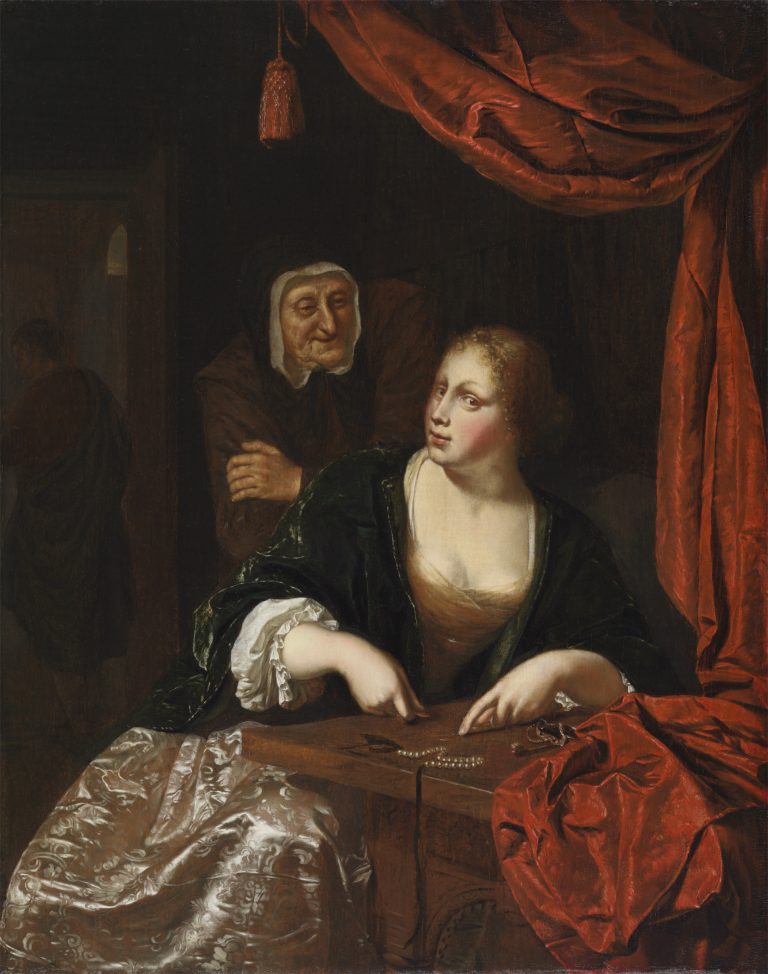“A lady counting money, with a jolly old woman, by Jan van Mieris” was the brief description given for this picture when it appeared in the 1707 sale of the Amsterdam collector Petronella de la Court.1 Behind a partially drawn red curtain partly obscuring a purse, a young woman puts a coin on the table as she gazes seductively at the viewer. The old woman standing behind her smiles as she looks approvingly at the young woman’s action. Taking into account several motifs—the young woman’s low décolleté, a canopied bed, and a man who is about to leave the room—the scene clearly takes place in a brothel where the young courtesan and her procuress happily divide their profits.2
Thematically as well as stylistically, the work is characteristic of genre pictures that Jan van Mieris painted around 1680 when he was training with his renowned father, Frans van Mieris the Elder (1635–81).3 These genre paintings, which feature highly finished and enamel-like surfaces, a meticulous rendering of the texture of fabrics, and the cool, smooth surfaces of a woman’s skin, demonstrate how much Jan was indebted to his father for his subjects, figure types and painterly technique.4
Jan van Mieris’s source of inspiration for Courtesan Counting Money comes from his father’s Woman with a Lapdog, Accompanied by a Maidservant of 1680 (FM-105), which probably depicts Bathsheba after the wizened old woman has delivered David’s letter to her (fig 1).5 The similarity in figure types in the two pictures is striking, especially in their facial features and clothing. Jan van Mieris’s courtesan wears a similar dark green velvet jacket with a plunging décolleté and a satin skirt that radiates a silvery luster, while the procuress, with a double hood covering her head, displays a comparably vulgar smile on her wrinkled face.6 Jan van Mieris, however, chose a different narrative structure. Whereas Frans the Elder focused on the moment of private confidence between the two women and alluded to the suitor only through the motif of the letter on the table, Jan van Mieris strove to clearly relate the course of events in the brothel. By adding pictorial elements such as the bed, the man leaving the room, and the pearl necklace on the table that must have been removed during the sexual transaction, Van Mieris suggests a linear series of actions leading up to the moment depicted.
One of the most striking differences between the two works is the relationship of the viewer to the scene. In Frans the Elder’s painting the woman’s averted gaze as she listens attentively to the old crone excludes the viewer from the privacy of the moment, whereas the courtesan in Jan van Mieris’s painting stares directly out at the viewer. She counts her money seductively, inviting her next customer to enjoy her pleasures. Jan’s pictorial device and suggestive subject matter were apparently appreciated by the distinguished art collector Petronella de la Court, who owned a number of his works and was likely the first owner of the present picture.7 The painting’s explicitly amorous message, however, was not evident to everyone. The art dealer Jan Pietersz Zomer, who compiled the list of paintings within the inventory of Petronella’s estate in 1707, described the picture as “een suynigh huyshouden” (a scene of prudent housekeeping), which is probably the most chaste interpretation of the scene the artist could ever have expected.8
